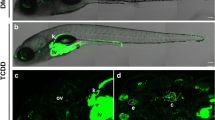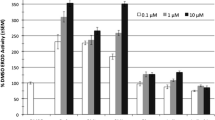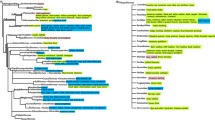Abstract
Some wild populations of fish-eating birds and raptors are exposed to high concentrations of 2,3,7,8-tetrachlorodibenzo-p-dioxin (TCDD) and related compounds such as other 2,3,7,8-substituted polychlorinated dibenzo-p-dioxins and polychlorinated dibenzofurans and coplanar polychlorinated biphenyls, resulting in accumulation in their tissues. It has been demonstrated that TCDD-like chemicals cause toxic effects via aryl hydrocarbon receptor (AHR)-mediated signaling pathways. The aim of this study was to characterize the AHR from the peregrine falcon (Falco peregrines) to predict its sensitivity to TCDD-like chemicals. The AHR1, AHR2, and AHR nuclear translocator 1 of the peregrine falcon are more similar in amino acid sequence to avian species less sensitive to TCDD-like chemicals such as the cormorant (95%) than to more sensitive species such as the chicken (90%). From the amino acid sequence, it is likely that the ligand-binding affinity of peregrine falcon AHR1 and AHR2 would be very low compared with the chicken or other sensitive species, and it was actually proved by an in vitro reporter gene assay. We concluded that the peregrine falcon, one of raptor species, may be relatively resistant to TCDD-like chemicals.




Similar content being viewed by others
References
Bird DM, Tucker PH, Fox GA, Laguë PC (1983) Synergistic effects of Aroclor 1254 and mirex on the semen characteristics of American Kestrels. Arch Environ Contam Toxicol 12:633–640
Blankenship AL, Hilscherova K, Nie M, Coady KK, Villalobos SA, Kannan K, Powell DC, Bursian SJ, Giesy JP (2003) Mechanisms of TCDD-induced abnormalities and embryo lethality in white leghorn chickens. Comp Biochem Physiol C 136:47–62
Brunstom B, Halldin K (1998) EROD induction by environmental contaminants in avian embryo livers. Comp Biochem Physiol C 121:213–219
Burbach KM, Poland A, Bradfield CA (1992) Cloning of the Ah-receptor cDNA reveals a distinctive ligand-activated transcription factor. Proc Natl Acad Sci 89:8185–8189
Clark KE, Stansley W, Niles LJ (2001) Changes in contaminant levels in New Jersey osprey eggs and prey, 1989 to 1998. Arch Environ Contam Toxicol 40:277–284
Denis M, Cuthill S, Wikstrom AC, Poellinger L, Gustafsson J-A (1988) Association of the dioxin receptor with the Mr 90,000 heat shock protein: a structural kinship with the glucocorticoid receptor. Biochem Biophys Res Commun 155:801–807
Elliott JE, Wilson LK, Henry CJ, Trudeau SF, Leighton FA, Kennedy SW, Cheng KM (2001) Assessment of biological effects of chlorinated hydrocarbons in osprey chicks. Environ Toxicol Chem 20:866–879
Fernandez-Salguero PM, Hilbert DM, Rudikoff S, Ward JM, Gonzalez FJ (1996) Aryl hydrocarbon receptor-deficient mice are resistant to 2,3,7,8-tetrachlorodibenzo-p-dioxin-induced toxicity. Toxicol Appl Pharmacol 140:173–179
Gill CE, Elliott JE (2002) Influence of food supply and chlorinated hydrocarbon contaminants on breeding success of bald eagles. Ecotoxicol 12:95–111
Hackett SJ, Kimbatt RT, Reddy S, Bowie RCK, Braun EL, Braun MJ, Chojnowski JL, Cox WA, Han K-L, Harshman J, Huddleston CJ, Marks BD, Miglia KJ, Moore WS, Sheldon FH, Steadman DW, Witt CC, Yuri T (2008) A phylogenic study of birds reveals their evolutionary history. Science 320:1763–1767
Hahn ME, Karchner SI, Evans BR, Franks DG, Merson RR, Lapseritis JM (2006) Unexpected diversity of aryl hydrocarbon receptors in non-mammalian vertebrates insights from comparative genomics. J Exp Zool 305:693–706
Head JA, Kennedy SW (2010) Correlation between an in vitro and an in vivo measure of dioxin sensitivity in birds. Ecotoxicol 19:377–382
Karchner SI, Kennedy SW, Trudeau S, Hahn ME (1995) Towards molecular understanding of species differences in dioxin sensitivity: initial characterization of Ah receptor cDNAs in birds and an amphibian. Mar Environ Res 50:51–56
Karchner SI, Franks DG, Kennedy SW, Hahn ME (2006) The molecular basis for differential dioxin sensitivity in birds: Role of the aryl hydrocarbon receptor. Proc Natl Acad Sci USA 103:6252–6257
Kennedy SW, Lorenzen A, Jones SP, Hahn ME, Stegeman JJ (1996) Cytochrome P4501A induction in avian hepatocyte cultures: A promising approach for predicting the sensitivity of avian species to toxic effects of halogenated aromatic hydrocarbons. Toxicol Appl Pharmacol 141:214–230
Kennedy SW, Jones SP, Elliott JE (2002) Sensitivity of bald eagle (Haliaeetus leucocephalus) hepatocyte cultures to induction of cytochrome P4501A by 2,3,7,8-tetrachlorodibenzo-p-dioxin. Ecotoxicol 12:163–170
Kim EY, Iwata H, Yasui T, Inoue N, Lee JS, Franks DG, Karchner SI, Hahn ME, Tanabe S (2008) Molecular basis for differential dioxin sensitivity in birds: characterization of avian AHR isoforms. In: Murakami Y, Nakayama K, Kitamura SI, Iwata H, Tanabe S (eds) Interdisciplinary Studies on Environmental Chemistry Vol. 1–Biological Responses to Chemical Pollutants. TERRAPUB, Tokyo, pp 81–86
Larkin MA, Blackshields G, Brown NP, Chenna R, McGettigan PA, McWilliam H, Valentin F, Wallace IM, Wilm A, Lopez R, Thompson JD, Gibson TJ, Higgins DG (2007) Clustal W and Clustal X version 2.0. Bioinformatics 23:2947–2948
Larson JM, Karasov WH, Sileo L, Stromborg KL, Hanbidge BA, Giesy JP, Jones PD, Tillitt DE, Verbrugge DA (1995) Reproductive success, developmental anomalies, and environmental contaminants in double-crested cormorants (Phalacrocorax auritus). Environ Toxicol Chem 5:553–559
Lee JS, Kim EY, Iwata H, Tanabe S (2007a) Molecular characterization and tissue distribution of aryl hydrocarbon receptor nuclear translator isoforms, ARNT1 and ARNT2, and identification of novel splice variants in common cormorant (Phalacrocorax carbo). Comp Biochem Physiol C 145:379–393
Lee JS, Kim EY, Iwata H (2007b) Dioxin activation of CYP1A5 promoter/enhancer regions from two avian species, common cormorant (Phalacrocorax carbo) and chicken (Gallus gallus): Association with aryl hydrocarbon receptor 1 and 2 isoforms. Toxicol Appl Pharmacol 234:1–13
Lubet RA, Connolly G, Kouri RE, Nebert DW, Bigelow SW (1983) Biological effects of the Sudan dyes. Role of the Ah cytosolic receptor. Biochem Pharmacol 32:3053–3058
Matsushita N, Sogawa K, Ema M, Yoshida A, Fujii-Kuriyama Y (1993) A factor binding to the xenobiotic responsive element (XRE) of P-4501A1 gene consists of at least two helix-loop-helix proteins, Ah receptor and ARNT. J Biol Chem 268:21002–21006
Mimura J, Yamashita K, Nakamura K, Morita M, Takagi TN, Nakao K, Ema M, Sogawa K, Yasuda M, Katsuki M, Fujii-Kuriyama Y (1997) Loss of teratogenic response to 2,3,7,8-tetrachlorodibenzo-p-dioxin (TCDD) in mice lacking the Ah (dioxin) receptor. Genes Cells 2:645–654
Peden-Adams M, Alonso K, Godard C, Skipper W, Mashburn W, Hoover J, Charbonneau C, Henshel D, Dickerson R (1998) Effects of environmentally relevant concentrations of 2,3,7,8-TCDD on domestic chicken immune function and CYP450 activity: F1 generation and egg injection studies. Chemosphere 37:1923–1939
Perdew GH (1998) Association of the Ah receptor with the 90 kDa heat shock protein. J Biol Chem 263:13802–13805
Perrière G, Gouy M (1996) WWW-Query: An on-line retrieval system for biological sequence banks. Biochimie 78:364–369
Refat NA, Ibrahim ZS, Moustafa GG, Sakamoto KQ, Ishizuka M, Fujita S (2008) The induction of cytochrome P450 1A1 by sudan dyes. J Biochem Mol Toxicol 22:77–84
Reyes H, Reisz-Porszasz A, Hankinson O (1992) Identification of the Ah receptor nuclear translator protein (ARNT) as a component of the DNA binding form of the Ah receptor. Science 256:1193–1195
Vorderstrasse BA, Steppan LB, Silverstone AE, Kerkvliet NI (2001) Aryl hydrocarbon receptor-deficient mice generate normal immune responses to model antigens and are resistant to TCDD-induced immune suppression. Toxicol Appl Pharmacol 171:157–164
Walker MK, Pollenz RS, Smith SN (1996) Expression of the aryl hydrocarbon receptor (AhR) and AhR nuclear translator during chick cardiogenesis is consistent with 2,3,7,8-tetrachlorodibenzo-p-dioxin-induced heart defects. Toxicol Appl Pharmacol 143:407–419
Whitelaw ML, Gottlicher M, Gustafsson J-A, Poellinger L (1993) Definition of a novel ligand binding domain of nuclear bHLH receptor: co-localization of ligand and hsp90 binding activity within the regulable inactivation domain of the dioxin receptor. EMBO J 12:4169–4179
Woodford JE, Karasov WH, Meyer MW, Chambers L (1998) Impact of 2,3,7,8-TCDD exposure on survival, growth, and behavior of ospreys breeding in Wisconsin, USA. Environ Toxicol Chem 17:1323–1331
Yasui T, Kim EY, Iwata H, Tanabe S (2004) Identification of aryl hydrocarbon receptor 2 in aquatic birds: cDNA cloning of AHR1 and AHR2 and characteristics of their amino acid sequences. Mar Environ Res 58:113–118
Yasui T, Kim EY, Iwata H, Tanabe S (2007) Functional characterization and evolutionary history of two aryl hydrocarbon receptor isoforms (AhR1 and AhR2) from avian species. Toxicol Sci 99:101–117
Acknowledgment
This study was supported in part by Grants-in-Aid for Scientific Research from the Ministry of Education, Culture, Sports, Science and Technology of Japan awarded to M. Ishizuka (No. 19671001).
Author information
Authors and Affiliations
Corresponding author
Additional information
Communicated by C. Gortázar
Rights and permissions
About this article
Cite this article
Fujisawa, N., Ikenaka, Y., Kim, EY. et al. Molecular evidence predicts aryl hydrocarbon receptor ligand insensitivity in the peregrine falcon (Falco peregrines). Eur J Wildl Res 58, 167–175 (2012). https://doi.org/10.1007/s10344-011-0559-1
Received:
Revised:
Accepted:
Published:
Issue Date:
DOI: https://doi.org/10.1007/s10344-011-0559-1




